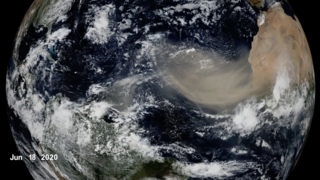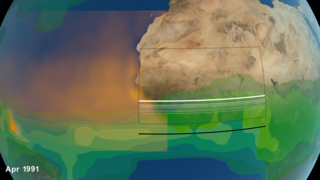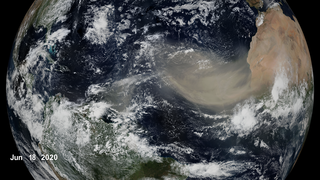Earth
ID: 4895
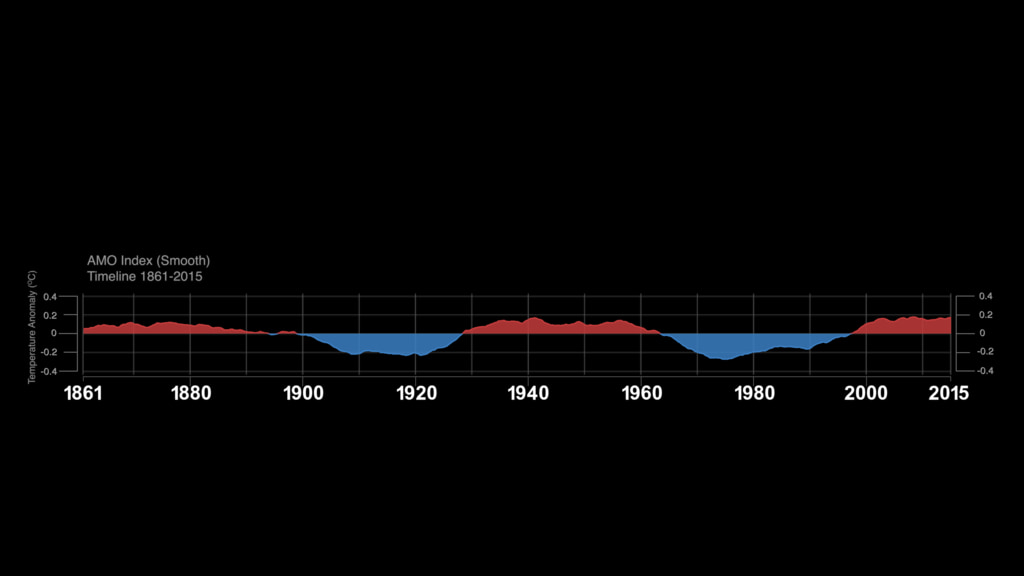
Data Sources:
The rest of this webpage offers additional versions, frames, layers and colorbar information, associated with the development of this data-driven visualization.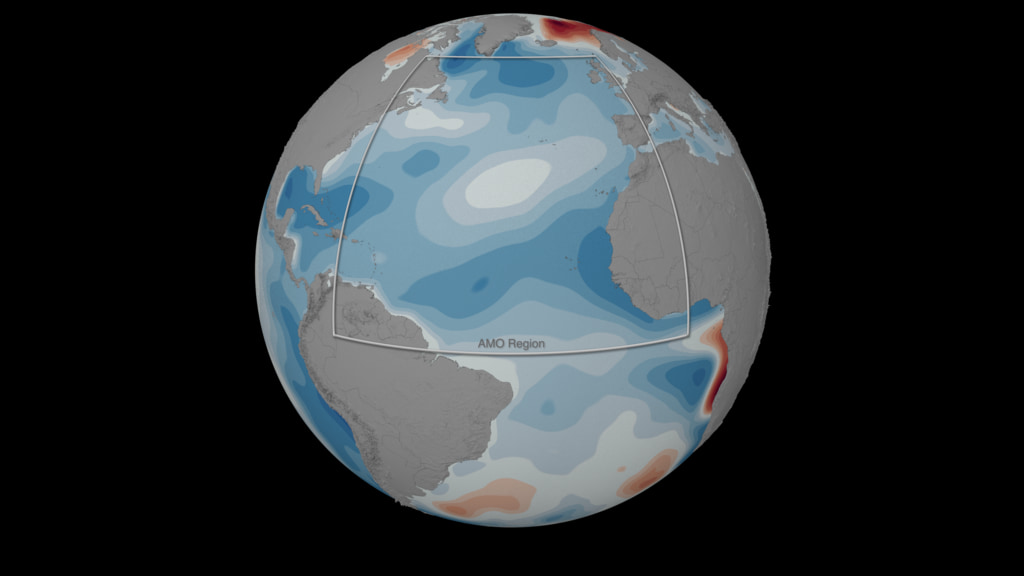

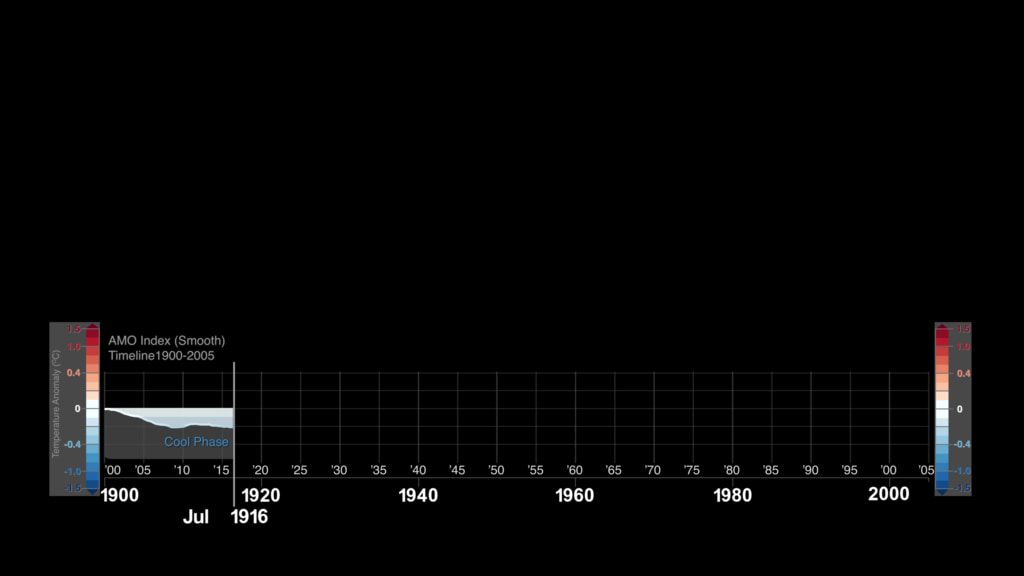

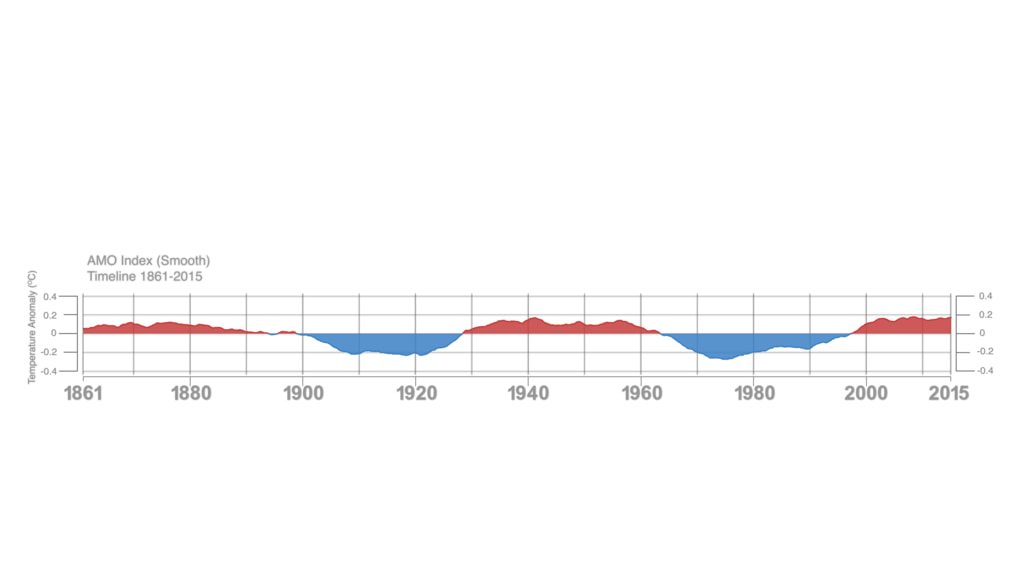
Historical Atlantic Multidecadal Oscillation (AMO)

Data Sources:
- Atlantic Mutlidecadal Oscillation (AMO) Index. The AMO Index is a monthly index of the North Atlantic temperatures from 1856 to present. This data visualization utilized the smoothed, long version of the AMO index. The data is available here: https://psl.noaa.gov/data/timeseries/AMO/
- Extended Reconstructed Sea Surface Temperature (ERSST) v5 (global monthly dataset). Data Citation: Boyin Huang, Peter W. Thorne, Viva F. Banzon, Tim Boyer, Gennady Chepurin, Jay H. Lawrimore, Matthew J. Menne, Thomas M. Smith, Russell S. Vose, and Huai-Min Zhang (2017): NOAA Extended Reconstructed Sea Surface Temperature (ERSST), Version 5. [Subset used: 1854-2020]. NOAA National Centers for Environmental Information. doi: 10.7289/V5T72FNM. [access date: February 2020].
For the purposes of this visualization the science team derived Sea Surface Temperature Anomaly (from ERSST v5) for the North Atlantic region (0-80N) for the period 1900-2005. - Blue Marble: Next Generation was produced by Reto Stöckli, NASA Earth Observatory (NASA Goddard Space Flight Center). Citation: Reto Stöckli, Eric Vermote, Nazmi Saleous, Robert Simmon and David Herring.
The Blue Marble Next Generation – A true color earth dataset including seasonal dynamics from MODIS, October 17, 2005. - Global 30 Arc-Second Elevation (GTOPO 30) from USGS. doi: 10.5066/F7DF6PQS
The rest of this webpage offers additional versions, frames, layers and colorbar information, associated with the development of this data-driven visualization.





Used Elsewhere In
Related
For More Information
Visualization Credits
Helen-Nicole Kostis (USRA): Lead Visualizer
Tianle Yuan (UMBC): Lead Scientist
Hongbin Yu (JCET UMBC): Scientist
Mian Chin (NASA/GSFC): Scientist
Lorraine Remer (NASA/GSFC): Scientist
David McGee (MIT): scientist
Amato Evan (University of California, San Diego): Scientist
Mark Zelinka (Lawrence Livermore National Laboratory): Scientist
Joel Norris (University of California, San Diego): Scientist
Lazaros Oreopoulos (NASA/GSFC): Scientist
Kerry G. Meyer (NASA/GSFC): Scientist
Steven Platnick (NASA/GSFC): Scientist
Kathryn Mersmann (USRA): Lead Producer
Ellen T. Gray (ADNET Systems, Inc.): Lead Writer
Lara Streiff (GSFC Interns): Producer
Laurence Schuler (ADNET Systems, Inc.): Technical Support
Ian Jones (ADNET Systems, Inc.): Technical Support
Eric Sokolowsky (Global Science and Technology, Inc.): Project Support
Leann Johnson (Global Science and Technology, Inc.): Project Support
Tianle Yuan (UMBC): Lead Scientist
Hongbin Yu (JCET UMBC): Scientist
Mian Chin (NASA/GSFC): Scientist
Lorraine Remer (NASA/GSFC): Scientist
David McGee (MIT): scientist
Amato Evan (University of California, San Diego): Scientist
Mark Zelinka (Lawrence Livermore National Laboratory): Scientist
Joel Norris (University of California, San Diego): Scientist
Lazaros Oreopoulos (NASA/GSFC): Scientist
Kerry G. Meyer (NASA/GSFC): Scientist
Steven Platnick (NASA/GSFC): Scientist
Kathryn Mersmann (USRA): Lead Producer
Ellen T. Gray (ADNET Systems, Inc.): Lead Writer
Lara Streiff (GSFC Interns): Producer
Laurence Schuler (ADNET Systems, Inc.): Technical Support
Ian Jones (ADNET Systems, Inc.): Technical Support
Eric Sokolowsky (Global Science and Technology, Inc.): Project Support
Leann Johnson (Global Science and Technology, Inc.): Project Support
Please give credit for this item to:
NASA's Scientific Visualization Studio
NASA's Scientific Visualization Studio
Science Paper:
Yuan T, Yu H, Chin M, Remer LA, McGee D, Evan A. Anthropogenic Decline of African Dust: Insights From the Holocene Records and Beyond. Geophysical research letters. 2020 Nov 28;47(22):e2020GL089711. doi:10.1029/2020GL089711
Yuan T, Oreopoulos L, Zelinka M, Yu H, Norris JR, Chin M, Platnick S, Meyer K. Positive low cloud and dust feedbacks amplify tropical North Atlantic Multidecadal Oscillation. Geophysical Research Letters. 2016 Feb 16;43(3):1349-56. doi:10.1002/2016GL067679
Short URL to share this page:
https://svs.gsfc.nasa.gov/4895
Data Used:
Note: While we identify the data sets used in these visualizations, we do not store any further details nor the data sets themselves on our site.
Keywords:
SVS >> Dust Storm
SVS >> Sea Surface Temperature Anomaly
SVS >> Hyperwall
NASA Science >> Earth
NASA Earth Science Focus Areas >> Climate Variability and Change
Yuan T, Yu H, Chin M, Remer LA, McGee D, Evan A. Anthropogenic Decline of African Dust: Insights From the Holocene Records and Beyond. Geophysical research letters. 2020 Nov 28;47(22):e2020GL089711. doi:10.1029/2020GL089711
Yuan T, Oreopoulos L, Zelinka M, Yu H, Norris JR, Chin M, Platnick S, Meyer K. Positive low cloud and dust feedbacks amplify tropical North Atlantic Multidecadal Oscillation. Geophysical Research Letters. 2016 Feb 16;43(3):1349-56. doi:10.1002/2016GL067679
Short URL to share this page:
https://svs.gsfc.nasa.gov/4895
Data Used:
GTOPO30 Topography and Bathymetry
Data Compilation - USGSTerra and Aqua/MODIS/Blue Marble: Next Generation also referred to as: BMNG
Credit:
The Blue Marble data is courtesy of Reto Stockli (NASA/GSFC).
The Blue Marble data is courtesy of Reto Stockli (NASA/GSFC).
Atlantic Multidecadal Oscillation (AMO) Index also referred to as: AMO Index
Analysis - NOAAExtended Reconstructed Sea Surface Temperature (ERSST) v5 also referred to as: ERSST v5
Analysis - NOAA National Centers for Environmental InformationKeywords:
SVS >> Dust Storm
SVS >> Sea Surface Temperature Anomaly
SVS >> Hyperwall
NASA Science >> Earth
NASA Earth Science Focus Areas >> Climate Variability and Change
